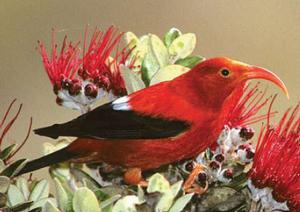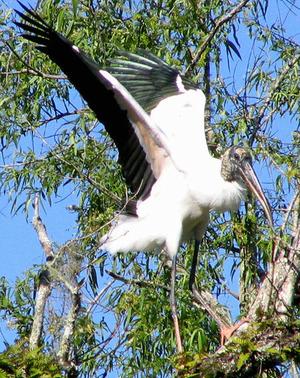U.S. Birds Struggling to Survive Habitat Loss, Climate Change
WASHINGTON, DC, March 19, 2009 (ENS) - Nearly one-third of the more than 800 bird species in the United States are endangered, threatened or in decline due to climate change, habitat loss, and invasive species, finds the first comprehensive report ever produced on U.S. bird populations.
At a news conference in Washington today, Secretary of the Interior Ken Salazar released the report, which was developed by a partnership among the U.S. Fish and Wildlife Service, the U.S. Geological Survey, state government wildlife agencies and nongovernmental organizations.
"Just as they were when Rachel Carson published "Silent Spring" nearly 50 years ago, birds today are a bellwether of the health of land, water and ecosystems," Salazar said. "From shorebirds in New England to warblers in Michigan to songbirds in Hawaii, we are seeing disturbing downward population trends that should set off environmental alarm bells. We must work together now to ensure we never hear the deafening silence in our forests, fields and backyards that Rachel Carson warned us about."
 |
The I'iwi is unique to the Hawaiian islands and classed as Vulnerable to extinction. (Photo by Jack Jeffrey Photo courtesy DOI) |
In Hawaii, more birds are in danger of extinction than anywhere else in the United States. More than one-third of all bird species listed under the Endangered Species Act occur in Hawaii and 71 bird species have gone extinct since people came to the islands in about 300 AD. At least 10 more bird species have not been seen in 40 years and may be extinct.
Dr. Sam Gon III, senior scientist and cultural advisor for The Nature Conservancy of Hawaii, said that too many Hawaiian bird species are on the brink and more money is needed to address the primary cause – destruction and loss of native habitat.
"Considering the heroic efforts that are needed to control habitat loss and degradation, as well as direct threats such as disease and invasion by non-native plants and animals, much more support should be directed toward habitat protection in Hawaii," Gon said.
"It's been shown in our native forests, for example, that when efforts are made to stabilize habitat for one species, the benefits are enjoyed by the many species that share that habitat," he said.
The report calls for greater investment to protect remaining Hawaiian forests that shelter rare birds, elimination of invasive predators, and captive breeding of endangered species before they too vanish into extinction.
Elsewhere birds are also in trouble, the report finds. Grassland birds are among the fastest declining birds in North America - 48 percent are of conservation concern and 55 percent are showing significant declines.
High commodity prices and demand for biofuels contribute to reduced acreage for farm conservation programs. Wind turbines, if improperly sited, can fragment grasslands and disrupt nesting activity of birds such as lesser prairie-chickens.
Global warming is expected to increase drought conditions in grassland regions, leading to reduced food for birds. Conversion of grasslands to agriculture has destroyed habitat and pumped pesticides and other toxics into the environment.
Invasive plants and animals are major threats. Domestic and feral cats kill hundreds of millions of birds each year. Island nesting birds, particularly seabirds, are vulnerable since they nest on the ground or in burrows and are preyed upon by rats, foxes, cats, dogs, and mongooses.
 |
Western meadowlark, a grassland bird in decline, was designated the Nebraska official state bird in 1929. (Photo by John and Karen Hollingsworth courtesy FWS) |
The accelerated pace of urban, suburban, and commercial development in the United States threatens the integrity of every major habitat, from continued draining of wetlands and destruction of coastal marshes, to loss and fragmentation of forests, aridlands, and grasslands because of suburban sprawl. Many birds die when they collide with buildings.
Most U.S. forest ecosystems have been fragmented by logging, road building, tree plantations, and fire suppression. More than 85 percent of old-growth forest in the Pacific Northwest has been eliminated, leading to the listing of the Northern spotted owl and marbled murrelet as threatened under the Endangered Species Act.
In arid regions of the West where 30 percent of bird species are in decline, excessive grazing has degraded grasslands and denuded streamside areas where most bird species forage and breed. Overfishing in oceans has led to bird starvation and nesting failures.
Yet, the report finds places where habitat restoration and conservation have reversed previous declines, particularly in waterfowl species, offering hope that action to save vanishing populations might still be effective.
Covering the past 40 years, "The U.S. State of the Birds," synthesizes data from three long-running bird population surveys conducted by thousands of citizen scientists and professional biologists.
At the news conference, John Fitzpatrick from the Cornell Lab of Ornithology earned laughs and agreement from all speakers with his comment that "citizen science rocks."
"Data in this report were collected not by a few pinhead scientists but by millions of individuals who found that science is fun," Fitzpatrick said. "With a few minutes a year we can begin to pull together massive databases that show us not just the broad base but the smaller habitats - we are getting huge amounts of data."
Data comes from the North American Breeding Bird Survey, administered by the U.S. Geological Survey and Canadian Wildlife Service, and conducted at more than 4,000 sites by volunteer observers, providing data for 365 breeding species since 1968.
For 120 species that breed elsewhere but winter within the U.S., the report used trends from the National Audubon Society's Christmas Bird Count.
Trends for 13 waterfowl species were provided by the U.S. Fish and Wildlife Service and Canadian Wildlife Service from the Waterfowl Breeding Population and Habitat Survey, conducted by pilots and wildlife biologists.
 |
Wood Stork alighting at Hontoon Dead River in Florida. Wood storks are federally listed as endangered. (Photo by Mehmet Karatay) |
"The birds are sending us a wake-up call that the habitat destruction, climate change and shortsighted environmental policies of the past are combining to take a serious toll. We must address the warming of our climate and the loss of vital habitat through policy and on-the-ground action at every level," warned said John Flicker, president of the National Audubon Society.
"This report makes clear the need for urgent individual, collective and government action, and leaves little doubt that taking action can make a difference. Together, we can safeguard not only our birds, but the environment that sustains us all," he said.
"Audubon has sent this message before, and now, thanks to all who played a role in the 2009 U.S. State of the Birds Report, the birds' warning will be heard by more Americans than ever before – including our representatives in Congress and in our state capitals, and policy-makers in our communities."
Secretary Salazar said the U.S. Fish and Wildlife Service will be better funded by the Obama administration than it had been during the Bush years. "When we look back to last decade you see the Department of the Interior budget continued to decline to be one of bottom end budgets of all federal agencies. This impacts the Fish and Wildlife Service," he said, "because they don't have the funding to get the job done.
"The stimulus package funds the Fish and Wildlife Service, and the money will be out on the ground in the next couple of weeks," the secretary promised.
Money invested in bird conservation will pay back big dividends, said Darren Schroeder of the American Bird Conservancy. "Bird watching contributes $45 billion to our economy every year, but many species are in decline and some are threatened with extinction. One-third of all birds listed under the Endangered Species Act are Hawaiian birds, but under the previous administration they got only four percent of ESA species recovery funds."
Secretary Salazar said the listing and delisting of endangered bird species will be guided by science. "Science will show us the way." He called the report "a clarion call to action."
Salazar said the Obama administration will take on "the difficult but necessary undertaking of dealing with climate change."
"We are seeing we are having impacts on our bird species," the secretary said. "President Obama says we will have a new strategy for climate change for America.
Copyright Environment News Service (ENS) 2009. All rights reserved.
To subscribe or visit go to: http://www.ens-newswire.com